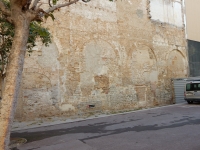
| For the photo's, see below |
| The complete website |
The Roman aqueduct of Barcelona - built in the first century CE according to an inscription from the time of Trajan (CIL II.4509) - has been physically ascertained in only a
very few places, but there are many medieval and modern documents referring to its arches. The route of the aqueduct has been studied in full depth in recent years by
Carme Miró and Héctor Orengo. The aqueduct might have been in service until the start of the seventh century.
The sections listed below correspond to the aqueduct Moncada.

|
| Imprint of the arcade of the Moncada aqueduct of Barcino (Roman Barcelona) in the Placa del Vuit de Marc. |
| Item | Info |
|---|---|
| Length | 11,3 km |
| Cross-section | 1,30 m x 0,60 m |
| Volume | 12.000 m3/day (at the source) |
| Gradient | 0,16 % |
| Period | 1st c CE |
| Features |
|
| Recommended literature : |
|
| Recommended websites : |
|
| How to visit : |
The visible remains of the Roman Moncada aqueduct of Barcino (present Barcelona) can be found in walking distance from the Placa Nova in the Gothic quarter of Barcelona: - Carrer Duran y Bas / Placa del Vuit de Marc (imprint) - Placa Nova (reconstruction) - Inside the Casa del Arcediano (adjacent to the city gate at the Placa Nova) |
| HOME | More literature on more aqueducts | Last modified: November, 2016 - (webmaster) |